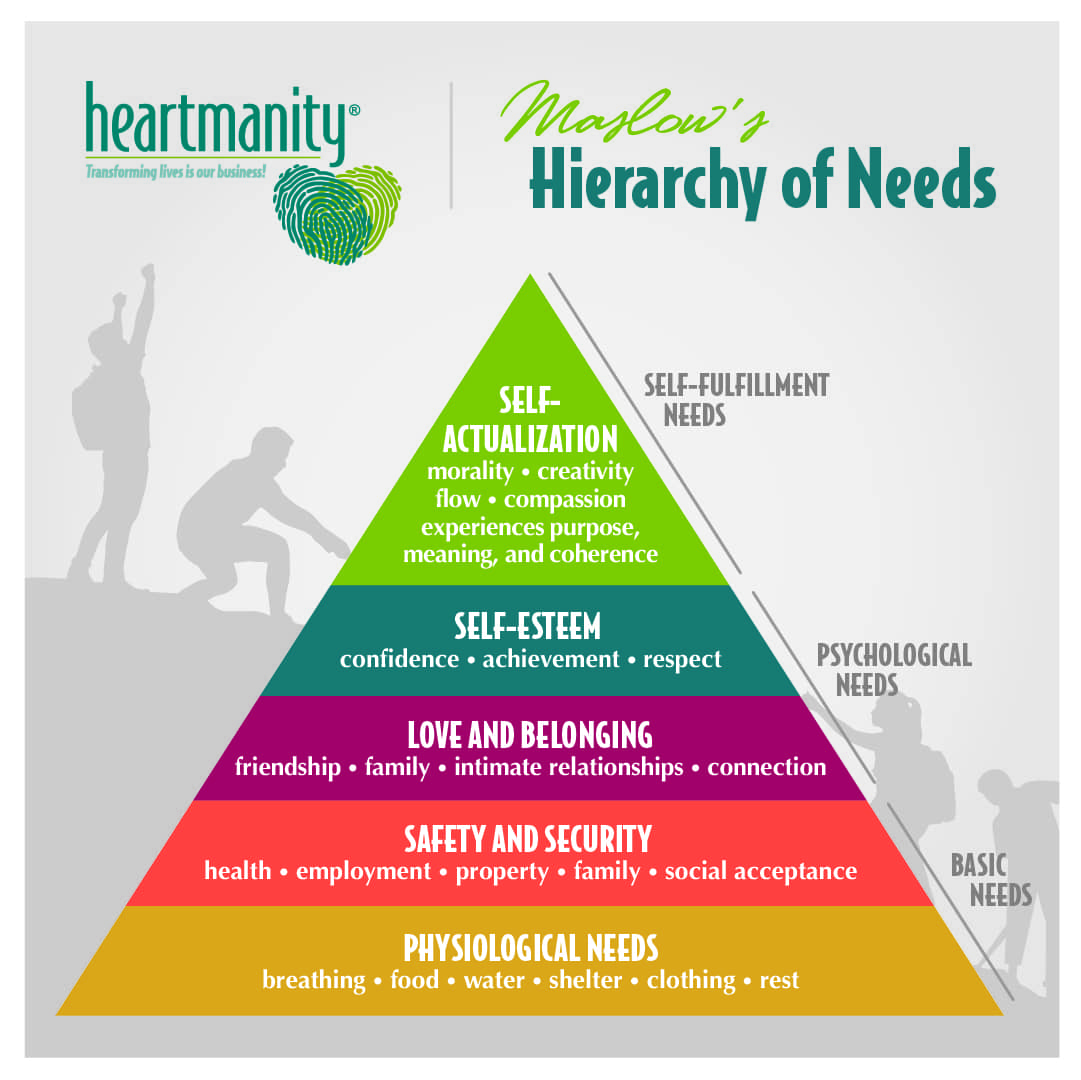Do you ever lose sight of what truly matters for your well-being and fulfillment? Feel out of whack?
Understanding how to prioritize our needs and goals is essential since they often compete with endless demands on our time. In both our personal and professional lives, the challenge of managing our commitments can feel overwhelming. As a solo-entrepreneur, I’ve found that being intentional helps with work-life balance and carving time for what truly matters.
EQ tools, such as Maslow's Hierarchy of Needs, can be an indispensable guide. They help us spot those times when we’ve let self-care slide or have moved into chronic stress or survival mode.
Estimated reading: 7 minutes
 Heartmanity is proud to partner with outstanding companies that we wholeheartedly recommend so this post may contain affiliate links. You can read our full disclosure here.
Heartmanity is proud to partner with outstanding companies that we wholeheartedly recommend so this post may contain affiliate links. You can read our full disclosure here.
Is Maslow's Needs Pyramid Still Relevant Today?
Although the framework of Maslow's Hierarchy of Needs was introduced in the 1940s, it is astonishingly relevant today, guiding us through the complexities of contemporary life.
This psychological needs theory offers insight into human motivation and provides a practical roadmap for navigating our daily lives with purpose and clarity. By understanding and applying Maslow's principles, we can systematically address our fundamental needs, build a solid foundation for personal growth, and pave the way toward achieving our fullest potential.
Let’s explore the pyramid of needs and how this iconic EQ tool can help you prioritize what’s truly important. From ensuring our basic psychological needs are met to continuously striving for self-actualization, applying Maslow’s theory can enhance your life.
And with all things, it’s not just what you know but how you apply and live what you know that up-levels your life. Maslow’s hierarchy can transform your approach to personal development and help you grow in emotional intelligence to achieve a balanced, fulfilling life.
So, let’s begin with the author of this monumental work.
Brief Biography of Abraham Maslow
Abraham Maslow was a renowned psychologist born in New York City on April 1, 1908. He began studying law at City College of New York. However, he switched to studying psychology at the University of Wisconsin, where he was mentored by Harry Harlow and earned all three of his psychology degrees (bachelor’s, master’s, and doctorate).
In the 1950s, Maslow was the founder and driving force behind humanistic psychology, which included theories about peak experiences, self-actualization, and the Hierarchy of Needs. His ideas differed from other popular theories at the time (Freud’s psychoanalytic theory and B.F. Skinner’s behavioral theory) in that he thought they were too negative. Instead, he focused on achieving full human potential, creativity, and maximizing well-being.
Maslow’s focus has always intrigued me. In my coaching work of the last couple of decades, I’ve found that we assert too much judgment on negative behaviors and overlook the underlying needs fueling “misbehavior,” whether at home with children, in our personal lives, or the workplace.
My specialty is decoding nonproductive behavior and teaching leaders and parents to redirect it to the true aims of the adult or child. It’s always fascinating to me just how quickly a person returns to respectful and loving behavior when their needs are met and the hidden pain is resolved.
Recognizing our own needs and those of others is what makes the needs pyramid so powerful.
Let’s dive into how Maslow’s pyramid was developed.
How and When Maslow Developed His Theory
Now that you know a bit about Abraham Maslow’s background and theories, let’s get into how and when he developed his most famous theory of human needs.
Starting in the 1940s, Maslow integrated his various approaches to human innovation. Then, in 1954, he published his groundbreaking book, Motivation and Personality which synthesized fifteen years of his human nature theories.
This book brought him international fame and critical acclaim and emphasized the positive side of psychology. The book also sparked interest from people in education and business management, as entrepreneurs sought advice on motivation and maximizing workplace team efficiency.
Later in life, Maslow became ill but continued writing, teaching, and consulting. Until he died in 1970, he firmly believed in human beings' potential to flourish. And after his death, his ideas continue to inspire millions worldwide. His legacy profoundly influences our understanding of what motivates us and the importance of fulfilling our needs to live our best lives.
How Maslow Expanded His Hierarchy of Needs
Interestingly, Maslow didn’t stop at his original five-tier pyramid. As his research and perspective evolved through the 1960s and 1970s, he recognized that human motivation was even more nuanced. Maslow introduced several additional needs, building upon his foundational model to better capture the full range of human potential and experience.
Here’s how the expanded hierarchy took shape:
Cognitive Needs: Beyond esteem, Maslow saw a fundamental human desire to know, understand, and explore. The drive for knowledge, curiosity, and intellectual growth became a distinct level, emphasizing that our quest for meaning is deep-rooted.
Aesthetic Needs: Maslow also identified a yearning for beauty, balance, and harmony. This level reflects how art, music, and appreciation of beauty enrich our lives and foster well-being—think of it as nourishment for the soul.
Self-Actualization: The familiar peak—striving to realize one’s fullest potential—remained central. This level is where creativity, personal growth, and authentic living shine brightest.
Transcendence Needs: Finally, Maslow recognized a powerful drive beyond the self—to connect with something greater, whether that’s helping others, embracing spiritual experiences, or seeking a deeper sense of purpose. This top tier invites us to look not just inward but outward, to make a meaningful difference in the world.
By broadening his pyramid, Maslow acknowledged the remarkable variety and richness of human needs—reminding us that our journey doesn’t end with personal fulfillment, but expands into seeking beauty, wisdom, and a sense of purpose beyond ourselves.
Maslow's Hierarchy of Needs
Maslow believed that understanding human needs was essential to creating a better world. This insight led him to conceptualize his theory as a pyramid with five levels, starting with basic physiological needs at the bottom and advancing to higher psychological needs, known as the Hierarchy of Human Needs.
Maslow’s theories have been applied in many areas, predominantly in education, business, and personal development.
See the illustration below as we go through each of the levels.

Progressing Through the Levels of Maslow’s Hierarchy
So, how do we move through Maslow’s pyramid?
The process typically starts from the bottom and moves upward, just as you would climb a ladder, but real life is sometimes less neat than a stack of building blocks.
When our most basic survival needs—like food, water, and safety—are satisfied, our attention naturally shifts upward to pursue new goals.
For example, when we feel physically safe and secure, we tend to crave connection and belonging. After we find our social footing and feel accepted, we’re drawn to seek respect, accomplishment, and recognition.
Interestingly, Maslow originally thought that these needs had to be met in a strict sequence, from the foundation up. However, as his research and experience with people grew, he realized the journey is far more personal and flexible.
Life’s unique circumstances, cultural backgrounds, and even certain seasons can cause people to prioritize one need over another—someone might long for achievement or respect even if their sense of belonging isn’t fully satisfied yet.
This dynamic nature is what makes Maslow’s theory so relatable and human. Our needs ebb and flow depending on where we are in life, sometimes circling back to basics, sometimes reaching for the highest forms of fulfillment. The important part is recognizing which needs are calling out for attention right now—and moving gently forward as we grow.
A Brief Description of Each Level of Maslow's Hierarchy of Needs
Let’s look at what each level of Maslow’s Hierarchy of Needs entails, starting with the broadest part of the pyramid (most important) and working up.
 Psychological Needs
Psychological Needs
We find our physiological needs at the pyramid's base, which sustains life. Think of these as everything the body needs to survive: air, water, food, shelter, and sleep. We create a stable foundation for our well-being and health by meeting these fundamental needs. These needs are a reminder that self-care starts with honoring the body's basic requirements.
 Safety Needs
Safety Needs
Once we meet our basic needs, we naturally seek safety and security. This level encompasses our desire for a safe living environment, financial security, health and wellness, and a net of protection against accidents and harm. It's about creating a sanctuary in our external environment and within ourselves, fostering inner peace and stability.
 Belonging and Love Needs
Belonging and Love Needs
Humans are inherently social creatures craving connection, love, and belonging. This stage in the pyramid emphasizes the importance of intimate relationships, friendships, and community ties. Did you know that our brains are literally wired for connection? Since our brains are built to be social, the needs for love and belonging are a high priority.

 Esteem Needs
Esteem Needs
Our esteem needs focus on our longing for respect, self-esteem, and recognition. This level involves achieving and mastering skills, independence, and receiving appreciation from others. It's a call to celebrate our accomplishments and to cultivate self-respect and confidence, acknowledging that our value comes from within and is reflected in our actions and how we treat others.
The Connection Between Esteem Needs, Self-Confidence, and Motivation
Esteem needs play a pivotal role in shaping both our self-confidence and our motivation to grow. When we nurture our sense of self-worth—through confidence, competence, and recognition—we lay the groundwork for ambition and perseverance. Achieving goals, feeling accomplished, or receiving appreciation from others all contribute to the internal belief that we are capable and valued.
On the flip side, when our esteem needs go unfulfilled—perhaps we lack recognition at work or feel overlooked in relationships—our confidence can waver. This dip in self-esteem often chips away at our motivation, making it harder to pursue new challenges or bounce back from obstacles. If we start believing we're destined to fall short, we're less likely to put in the effort or take healthy risks.
The good news?
Esteem grows stronger with each positive step: a completed project, meaningful acknowledgment, or simply mastering a new skill. Every achievement, big or small, becomes fuel for both our confidence and our drive to keep moving forward.
 Self-Actualization
Self-Actualization
Maslow first coined the term 'self-actualizing' and interviewed many high achievers to understand what made them emotionally healthy and prosperous. Through these interviews, he discovered the occurrence of peak experiences, which were often related to accomplishment or family life. Maslow also believed that self-actualizing people constantly try to reach their full potential and possess characteristics of self-acceptance, independence, and spontaneity.
According to Abraham Maslow, the highest need—the ultimate goal—as human beings is self-actualization. You’ll find it at the top of Maslow's hierarchy, representing one's potential, creativity, and personal growth. This focus is centered on authenticity, pursuing our passions, and fulfilling our purpose.
Each level represents human needs. A growth journey encourages continuous exploration, learning, and embracing growth opportunities. However, these pursuits become unlikely when a person is homeless, starving, or even operating on burnout in the workplace.
Would Maslow's Pyramid Be Better Suited and Helpful as a Circle?
As you have seen, Maslow's Hierarchy of Needs is traditionally depicted as a pyramid. (See visual above.) It has the most basic human requirements at the base and the more complex psychological needs at the top.
However, it could be helpful, and even more accurate, to envision these needs as part of a continuous, interconnected circle rather than a linear pyramid. This approach highlights that fulfilling one necessity often influences and is influenced by others, reflecting the dynamic nature of human motivation and growth.
Viewing Maslow's hierarchy as a circle accentuates the idea that these needs don't exist in isolation but are interconnected, supporting the mind-body connection. You don't just fulfill the bottom tier and then reach for the next. They are ALL important.
For example, achieving safety and security can impact one's ability to form relationships, while a sense of belonging can enhance self-esteem. If a child's physiological needs are met, yet they lack emotional support or security, their potential to reach higher levels of motivation and personal growth may still be hindered.
This interconnected perspective portrays a more holistic approach, emphasizing the importance of addressing all facets of human needs, development, and well-being. Rather than progressing step-by-step, each need fuels and reinforces the others, creating a balanced and comprehensive path to fulfillment.
A Major Criticism of Maslow's Hierarchy of Needs
Maslow’s Hierarchy of Needs is a central piece of psychological history that has profoundly influenced many aspects of human understanding.
But it’s not perfect.
The main criticism of Maslow’s theory is that it lacks universality and cultural difference considerations. Different cultures have different needs and priorities, and the hierarchy may be less relevant to individuals with different values and beliefs.
His theory neglects the impact of social and cultural factors and individual differences. For instance, communal cultures such as those in Asia, Middle East, and India, emphasize family and collective well-being rather than individualism and personal self-fulfillment needs or actualization. Their social structures are shaped to support community, family and society rather than individuals.
Cultural values and norms can significantly affect an individual’s needs and priorities, sometimes even superseding them. Therefore, consider cultural context when using the pyramid.
This shortcoming of Maslow’s Hierarchy of Needs highlights the importance of recognizing that human needs and motivations aren’t one-size-fits-all.
While we are all human, cultural differences play a significant part in deciding the course of our lives. People from different cultures have different priorities and aspirations, and their needs may be influenced by external factors such as social, economic, and environmental circumstances.
When Maslow first published his theory in 1943, he tried to encompass as many people as possible given limitations present at that time. But we must expand its parameters to apply it to today's world. Therefore, approach the understanding and use of the Hierarchy of Needs with cultural sensitivity and an appreciation of the complexity of human motivation.
How the Basic Needs Play Out in Modern Life
The world is much different now than when Maslow created the Hierarchy of Needs. However, his theory is valuable for gaining profound insights into our personal development today.
Modern-Day Psychological Needs
The pyramid's foundation begins with fulfilling our basic psychological needs of sustenance, hydration, and shelter. Today, we might push those elements to pursue wholesome, sustainable food options, exercising to strengthen our bodies, and find safe, welcoming spaces where we can relax and be authentic.
Recognizing and prioritizing these needs is fundamental to physical health and overall well-being. You can move on to the next level when your basic needs are met as best as possible.
Modern-Day Safety Needs
In modern times, we can broaden this level from only physical security to emotional and cyber security.
Much of our lives are online now—banking, shopping, friends, hybrid work, school, etc. —so creating digital empathy is crucial, especially with prevalent social media shaming.
And, of course, a safe space is also imperative for protecting ourselves and our loved ones from threats in our physical environments. If we extend this level further, we might include our planet’s environmental health, a concern for many.
Our emotional safety needs to be a priority today, too. In the past, many people, especially men, were taught to push their emotions down and buck up. Cutting ourselves off from our emotions limits our effectiveness, sometimes resulting in angry bursts. We know now that being emotionally healthy and having high emotional intelligence (EQ) is essential for a better life.

Modern-Day Love and Belonging Needs:
While love and relationships have evolved since the time Maslow created his Hierarchy of Needs, the human brain is wired for relationship and the need to belong is stronger than ever in our digital age. Direct human contact is still essential, even though the digital age allows us to “connect” with people instantly across the globe.
I recommend finding some balance in this area. You can value your online “friends” and enjoy the social media connections but also ensure you nurture and grow your relationships in person. Invite a friend to coffee or lunch. Pick up the phone and make a call. Hug someone (with their permission, of course). Go out on dates and have fun. Ensure your online interactions complement your physical ones rather than replace the richness of real-life experiences.
Heartmanity encourages nurturing these connections with openness and empathy, recognizing that our emotional health flourishes when we feel loved and supported.
Modern-Day Esteem Needs
Life moves faster today than ever before. Meeting our esteem needs—the desire for accomplishment, respect, and self-esteem—has been taken to a higher level. With the advent of social media, there are WAY more avenues for recognition and validation, offering instant feedback loops for our achievements and recognition.
However, true fulfillment goes beyond likes, clicks, views, and shares. It involves finding genuine satisfaction and deepening your self-respect in your personal and professional life. Set meaningful goals, embrace your unique strengths, and contribute to communities in meaningful ways. These simple actions enhance your sense of belonging and expand your authentic self.
Modern-Day Self-Actualization
Pursuing your full potential, embracing creativity, problem-solving, and achieving personal growth in the modern world can be more challenging with myriad distractions, yet simultaneously more accessible.
Today, we have unprecedented access to information, diverse communities, and nearly limitless opportunities for learning and expression. We have varied and plentiful paths to personal and professional development.
However, self-actualization is a journey, not a destination. It’s not just about acquiring knowledge. Wholeness and integration is a deep, ongoing process of aligning our actions with our true selves, developing our intuition, exploring our passions, and contributing meaningfully to the world. You’ll need mindfulness, resilience, and an openness to experience life fully—including embracing all your challenges as opportunities for growth.
Maslow’s Hierarchy of Needs is as prevalent in our everyday lives as ever. The same principles apply; only the original hierarchy has evolved to include the elements of our modern world.
A Real-Life Personal and Workplace Example of Maslow’s Hierarchy of Needs
Knowing which of our needs must be met and in what order can be complex. So, let’s look at two examples (personal and workplace) to understand better how to apply Maslow’s Hierarchy of Needs in real life.
Personal Example
Let’s say you feel sluggish, your dating and work life are stagnant, and life doesn’t seem to be going your way. Many might immediately think caffeinated drinks, dating apps, scrolling social media, and moving on to a new job will “fix” their lives.
However, according to Maslow’s Hierarchy of Needs, fulfilling your basic psychological needs comes first: food, water, warmth, and rest, before jumping to external “things” to find happiness.
Well-being requires us to prioritize our physical needs of hydration, creating a bedtime routine that promotes relaxation, going to the gym for exercise, and planning meals to ensure you have nourishing food readily available.
Meeting the basics first can alleviate a lot of your stress, increase self-confidence, and improve your overall well-being. Start providing everything at the bottom of Maslow’s pyramid for yourself. Then, reach out to a good friend and increase connection. Work up from there!

Workplace Example
Imagine you’re the owner of a veterinarian clinic with fifteen employees at each of your three locations. In a workplace setting, Maslow's Hierarchy of Needs can be used to improve employee experience, motivation, and satisfaction as well as the needs of your customers.
For example, an owner or employer can ensure that employees' physiological needs are met with providing access to purified water, a relaxing and attractive break room, a comfortable working environment, and a fair income. Creating a clean, professional, welcoming space for customers, friendly service will ensure their basic needs. Furnishing a convenient restroom and an organized reception area will help them feel at home.
Meet first-level needs first, then address safety needs, such as an easy entrance for customers and a spacious, comfortable waiting area. For employees: job security, a safe working environment, and adequate on-the-job training are fulfilling the second level needs.
After an employer meets these needs, they can focus on social needs by creating opportunities for team building and socializing to foster a sense of belonging. You could also plan a public event with food and refreshments for customers, extending to them a greater sense of belonging.
Keep in mind, depending on your business, providing employees a strong sense of belonging at work is more difficult in our hybrid, Zoom and Slack-focused world. A special effort will need to be made to include off-site employees.
Finally, employers can help employees fulfill their esteem needs by providing recognition, opportunities for growth, emotional intelligence training, and appropriate involvement in decision-making.
Closing Thoughts
Maslow’s Hierarchy of Needs may have been formulated and introduced decades ago, but its principles are still relevant today. They can be instrumental in keeping life’s priorities in order.
Our lives are driven by needs so understanding what needs are fueling our behavior can be extremely empowering.
It’s pretty simple system for well-being: start at the bottom and ensure your most basic needs are fulfilled first: getting enough sleep, healthy eating and drinking, exercising, and having a safe place to rest. Then move to each subsequent level.
The one vital key to a happy life: fulfilling your needs and sharing your life with others.
Ready to transform your everyday life with nuggets of wisdom?
Subscribe to our newsletter for insightful tips on navigating your needs and achieving personal growth.
Frequently Asked Questions
Was Maslow's Theory Based on a Diverse Population?
It’s important to recognize the context in which Maslow developed his theory. When selecting his subjects for studying “self-actualized” individuals, Maslow focused primarily on a small group—mainly highly educated men from Western, Caucasian backgrounds. Women were later included in his research, but they too tended to come from privileged and similar backgrounds, lacking diversity in terms of ethnicity, culture, and socioeconomic experience.
This limited sample shaped the foundational ideas behind the Hierarchy of Needs. While groundbreaking at the time, it also means Maslow’s work doesn’t represent the vast complexity and richness of the broader human population. It’s a helpful model, but one to adapt thoughtfully with awareness of its original narrow lens.
What happens if our human needs in Maslow's pyramid are not met?
In Maslow's Hierarchy of Needs, he believed that as people met the needs of each level, at least partially, they ascend to the next level.
Brain science shows us that our brains are programmed for survival so it makes sense that the most urgent needs are the highest priority. If we lack water and food, because we could die, they would become all-consuming.
However, because we are complex human beings with spiritual beliefs and deep values, we might seek spiritual guidance even as we lack the basics. And because the limbic brain seeks connection with other humans, we might also seek connection and love simultaneously as we pursue our survival needs.
The needs pyramid is a guide, not a hard-and-fast rule. Listen to your own heart to interpret what is most needed for your well-being.
Embark on a journey to self-actualization with us—from Maslow's Hierarchy of Needs and beyond. Contact us for personalized support.










